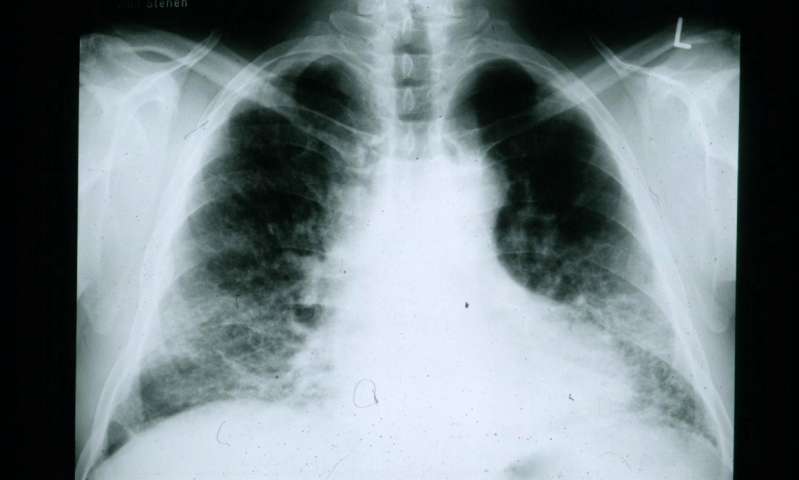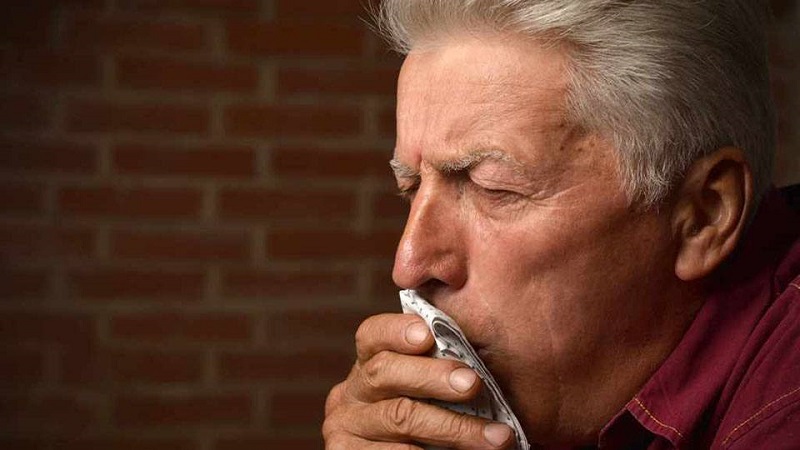Breakthrough Cures for Respiratory Diseases and COPD in the Pipeline
Summary: In a paradigm shift, scientists are starting to regard respiratory disease as a disease of aging and scientists at the Mayo Clinic reversed symptoms of lung disease in mice using age-reversing senolytic compounds. [This article first appeared on the website LongevityFacts.com as was updated on Feb 26, 2018. Author: Brady Hartman.]
All of us – both smokers and non-smokers alike – will lose significant lung capacity as we age. Scientists at the Mayo Clinic have developed a promising treatment that rejuvenates the damaged lungs of mice using anti-aging compounds called senolytics.

The Mayo Clinic researchers showed evidence linking the biology of aging with idiopathic pulmonary fibrosis (IPF), a disease of aging that impairs lung function and causes fatigue, shortness of breath, declining quality of life, and, ultimately, death. The Mayo Clinic team showed that the lungs of human IPF patients are full of senescent cells, and treatment with senolytics reversed symptoms of the lung disease in mice. Moreover, because senolytics have general age-reversing effects, the Mayo researchers hope to test the therapy on seniors with IPF as well as other lung diseases of aging.
Respiratory Disease is Similar to Aging
Recently, scientists have made considerable progress in understanding the underlying causes of COPD and other respiratory diseases. These lung diseases share many of the characteristic hallmarks of aging such as cellular senescence, telomere shortening, DNA damage, chronic inflammation (inflammaging), and epigenetic changes. Researchers are attacking the underlying mechanisms that cause respiratory diseases that make our lives miserable as well as shorten it.
Got Lungs?
Chronic lung disease has surpassed stroke to assume its position as the third leading killer, after heart disease and cancer. All of us will lose lung capacity we grow older. Respiratory diseases are a common cause of death and suffering in the elderly in both non-smokers and smokers alike. While the problem is made much worse by smoking and air pollution, the aging process reduces lung elasticity, the efficiency of the chest wall and respiratory strength.
Even if breakthrough medical advances could eliminate heart disease and cancer, we will still have to contend with respiratory diseases. We need to breathe about tens of thousands of times a day, and we can’t do so without healthy lungs. Keeping our lungs in tip-top shape is a vital component of staying healthy to ripe old age.
Chronic obstructive pulmonary disease (COPD) is a term for a subset of several types of respiratory diseases, including bronchitis and emphysema. Most COPD therapies, such as bronchodilators that widen the airways, aren’t disease-altering and are only designed to improve the patient’s suffering.
COPD is the second largest respiratory disease and can also cause pulmonary arterial hypertension, which in turn can contribute to heart disease. Many lung diseases are related to each other, and quite often, patients will have several forms of respiratory disease at the same time.
Respiratory disease increases with age and our lungs, bronchi, tracheas, and the nerves and muscles associated with breathing all decline in efficiency. Significant respiratory diseases in the elderly include mesothelioma, asthma, pneumonia, emphysema, pulmonary hypertension, pulmonary embolisms, idiopathic pulmonary fibrosis, and pneumonia, which can be fatal.

Mechanisms Underlying Respiratory Diseases
A team led by leading longevity researcher, Nathan LeBrasseur, Ph.D., director of the Healthy Aging program at the Mayo Clinic found a way to reverse symptoms of IPF in the lungs of mice by treating them with senolytics. The scientists published their findings earlier this year in the journal Nature Communications and issued a press release saying that they had progressed one step closer toward a possible therapy for individuals suffering from idiopathic pulmonary fibrosis.
Idiopathic pulmonary fibrosis is a disease that increases with age in which the lung tissue becomes scarred or inflamed, making it harder to breathe. As Dr. LeBrasseur describes it
“Individuals with idiopathic pulmonary fibrosis express difficulty completing routine activities. There are currently no effective treatment options, and the disease leads to a dramatic decrease in health span and life span, with life expectancy after diagnosis between three to five years.”
Dr. LeBrasseur and his team found that the markers of cellular senescence were higher in people with IPF and that the numbers of these senescent cells increase as the disease progresses, accelerating the aging process in the lungs. Senescent cells are damaged cells that refuse to die and provoke inflammation that wreaks havoc on the surrounding tissues. Cellular senescence is a process of aging triggered by natural factors such as telomere shortening. As well the process is triggered by macromolecular damage to the cells, most notably by DNA damage.
Marissa Schafer, Ph.D., a postdoctoral fellow in Dr. LeBrasseur’s laboratory and lead author of the study explained
“We discovered that senescent cells, which accumulate in the idiopathic pulmonary fibrosis lung, are a viable source of multiple factors that drive fibrotic activation.”
Dr. LeBrasseur’s then demonstrated that factors secreted by senescent cells could drive inflammation and aberrant tissue remodeling and fibrosis, which are hallmarks of IPF. Dr. LeBrasseur says the findings represent a conceptual shift in the way the scientists think about idiopathic pulmonary fibrosis, and the Mayo clinic researcher said
“Up to this point, research efforts have largely focused on understanding the unique elements that contribute to idiopathic pulmonary fibrosis. Here, we are considering whether the biology of aging is accelerated in this aggressive disease. What we’ve found is that senescent cells are prevalent, secreting toxic molecules that affect healthy cells in that environment and are essentially promoting tissue fibrosis.”
Equipped with the findings from their studies of human lung tissue, the Mayo Clinic team then replicated the process in mice. The researchers found that, much like in humans, mice with clinical symptoms of IPF also had increased numbers of senescent cells.
Results of Mayo Clinic Senolytic Experiments
The Mayo Clinic team used a genetic mouse model programmed to make senescent cells self-destruct and tested a combination of the senolytic compounds dasatinib and quercetin. Previous studies show that this combination eliminates senescent cells.
The mice treated with the senolytic combination showed remarkable improvements in measures of lung function and physical health, including better scores on treadmill tests. In other words, the treatment partially reversed the symptoms of IPF in these specially-bred mice.
Dr. LeBrasseur suggests that senolytic drugs might not only help IPF patients but could also be used to restore a more youthful respiratory system in older people who don’t have the disease, saying
“We are exploring whether senolytic drugs, or drugs that can selectively kill senescent cells, can be used for the treatment of aging-associated conditions, including idiopathic pulmonary fibrosis. More research is needed to validate this, and our goal is to move quickly from discovery to translation to application, and, ultimately, meet the unmet needs of our patients.”
Respiratory Diseases and Aging
Other researchers besides LeBrasseur’s team have made the connection between aging and lung disease. For example, early this year, Peter J. Barnes of the National Heart and Lung Institute at the Imperial College London linked respiratory diseases to the biology of aging and published his findings in the Annual Review of Physiology. Barnes pointed out that lung cells in COPD patients exhibit the same characteristics of aging cells elsewhere in the body, saying
“Chronic obstructive pulmonary disease (COPD) is regarded as a disease of accelerated lung aging. This affliction shows all of the hallmarks of aging, including telomere shortening, cellular senescence, activation of PI3 kinase-mTOR signaling, impaired autophagy, mitochondrial dysfunction, stem cell exhaustion, epigenetic changes, abnormal microRNA profiles, immunosenescence, and a low-grade chronic inflammation (inflammaging). ” adding ” Many of these pathways are driven by chronic exogenous and endogenous oxidative stress.” Saying later “There is also a reduction in antiaging molecules, such as sirtuins and Klotho, which further accelerate the aging process.“
Barnes lays the blame for this accelerated lung aging on free radical damage caused by cigarette smoke. As Barnes points out,
“Although these are normal aging processes that are common to all, these processes are accelerated in the lungs of smokers mostly due to free radical damage (oxidative stress) caused by cigarette smokers.”
Respiratory Disease Set to Increase Worldwide
If it pans out, LeBrasseur’s senolytic therapy could be the first disease-modifying cure for respiratory diseases. This would be a welcome development because analysts expect respiratory diseases to increase worldwide, due to increases in air pollution and smoking, two of the leading causes of lung disease
Although smoking rates have significantly declined in the developed world, cigarette smoking has increased worldwide. Sadly, cigarette companies have found a growing market in developing countries, and the number of smoking-related deaths will increase in these areas.
Even in developed countries, where smoking rates have declined by half in the last 50 years, chronic lung disease will persist as a leading cause of death, mostly due to an increase in cigarette smokers born in the 1940’s to 1950’s.
Even if cigarettes were outlawed worldwide – as has already been done in the country of Bhutan – the rise in global air pollution will become a significant source of death and disability. Researchers predict worldwide fossil fuel use to increase 50% by the year 2040. Increased use of fossil fuel portends further increases in air pollution, which has well-documented ill effects on lung and heart disorders. For example, increases in household coal use in northern China since 1950 has shortened life expectancy by 5.5 years from deaths due to lung and heart disease caused by increased air pollution.
Advances in Palliative Treatment
Until the first cure is found, researchers are improving palliative treatment for respiratory diseases. Lung diseases are difficult to treat, and most care is palliative, helping to relieve the symptoms but not treat the underlying disease.
Bottom Line
Scientists are increasingly viewing lung disease as a disease of aging and have identified many of its underlying cellular causes. Based on this new understanding, researchers are developing promising treatments for respiratory conditions, such as senolytics drugs.
Related: Scientists report the regeneration of lung tissue in patients using stem cells.
Show Us Some Love
- One click helps us spread the word – Share this post on social media and spread the word. It only takes one click on any of the social media links on this page.
- Follow us on social media – Google+ | Reddit
- Sign up for our email list – We use your email to notify you of new articles. We will not send you spam, and we will not share your email address. You can cancel at any time.
- Tell us what you think – Scroll down to enter your comments below.
References
Mayo Clinic News Network. “Mayo Clinic Researchers Discover Link between Aging, Devastating Lung Disease.” [Press release] Mayo Clinic News Network, February 24, 2017. Link.
Marissa J. Schafer, Thomas A. White, Koji Iijima, Andrew J. Haak, Giovanni Ligresti et al. “Cellular senescence mediates fibrotic pulmonary disease.” Nature Communications 8, Article number: 14532 (2017). Feb 23, 2017. doi:10.1038/ncomms14532. Link.
Peter J. Barnes. “Senescence in COPD and Its Comorbidities.” Annual Review of Physiology Vol. 79:517-539, February 2017, https://doi.org/10.1146/annurev-physiol-022516-034314. Alternate Link.
Disclaimer
Diagnosis, Treatment, and Advice: This article is intended for educational and informational purposes only and is not a substitute for qualified, professional medical advice. The information and opinions provided herein should not be used during any medical emergency or for the diagnosis or treatment of any medical condition. Nearly all of the therapies depicted herein are considered experimental. Experimental therapies to treat lung disease carry a much higher risk than FDA-approved ones. Consult a qualified and licensed physician for the diagnosis and treatment of any and all medical conditions. Call 911, or an equivalent emergency hotline number, for all medical emergencies. As well, consult a licensed, qualified physician before changing your diet, supplement or exercise programs. Photos, Endorsements, & External Links: This article is not intended to endorse organizations, companies, or their products. Links to external websites, mention or depiction of company names or brands, are intended for illustration only and do not constitute endorsements.

COPD and IPF are different diseases with different therapies. Just because senolytics worked in mice with IPF doesn’t mean they work in COPD as well.
you are correct. COPD and IPF are different diseases with different palliative therapies that form the current standard of care. These palliative therapies do not treat the underlying pathology. If COPD is characterized by large numbers of senescent cells, then senolytics could possibly treat COPD as well.
After my 3rd pulmonary embolism in 2003, I was diagnosed with pulmonary fibrosis and I read that people usually die within 5 years. My specialist has me on blood thinners, prednisone and other steroids that I inhale daily. October 2006 I decided to go with natural treatment and was introduced to Mbeki Herbal Clinic natural organic COPD Herbal formula, i had a total decline of symptoms with this COPD Herbal formula treatment. The infections, shortness of breath, fatigue, dry cough and other symptoms has subsided. Somehow, the herbs managed to keep me alive for 13 years.Visit Mbeki Herbal Clinic official website